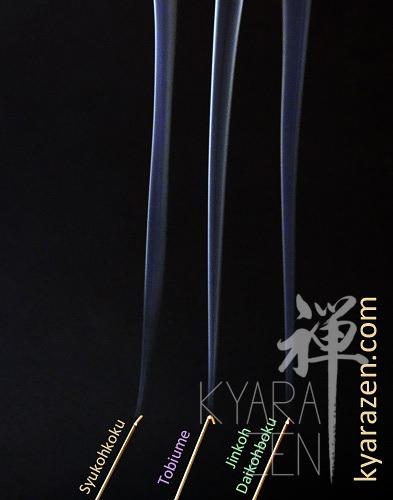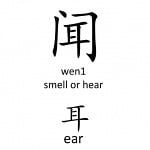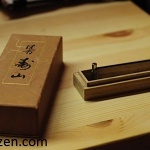
Apologies for the slow update, this article was taking quite a while to write and required several revisitations to the respective incenses over a few days before I could finalize it. It is into its 7th revision now and I’m publishing it for the time being, subjected to further edits.
I thought I would challenge myself and bring incense review to a slightly higher level by providing some form of comparison between incenses that I would classify or lump together due to their olfactory profile and dominant notes. Do give me some feedback via the contact page or my email at kyarazen AT gmail dot com if you would think this sort of comparative article is useful and not too confusing 🙂
It is autumn now, and today is the Mid Autumn festival, where the Chinese would have family gatherings, eat some ultra high calorie pastries called the “Moon Cake”, have some tea and play with lanterns. Autumn is also a good time for harvesting herbs, particularly those herbal roots going into quiescence as the temperature declines. In preparation for the winter, plants and many wild animals begin to prepare storage reserves to survive the cold, and to be ready for a new cycle of revival and growth in Spring.

Seen in the Mukasa no Takimono, and also chinese and taiwanese literature, the Sour taste/scent is the scent for Spring. The philosophy behind this, is that soury, tangy notes whet one’s appetite, and thus helping in promoting growth in Spring season.
Sour, is one of my favourite notes, and these three incenses, Baieido’s Syukohkoku, Baiedo’s Tobiume and Seikado’s Jinkoh Daikohboku are what I personally would consider to be classical in terms of presenting the acidic tangy note.

Brand : Baieido – Syukohkoku, Baieido – Tobiume, Seikado – Jinkoh Daikoboku
Source : Purchased from Japan
Price :
Syukohkoku 2100 yen / 65 grams (USD $21?)
Tobiume 1050 yen / 60 grams (USD $11?)
Jinkoh DKBK 1785 yen / 100 grams (USD $18?)
Amount Burnt so far prior to this review :
Syukohkoku 3/4 Box
Tobiume Approx 10 sticks
Jinkoh DKBK Approx 15 sticks
Taste profile :
Syukohkoku Sour : ++ Spicy + Sweet : ++ Bitter +
Tobiume Sour : +++ Spicy + Sweet : +
Jinkoh DKBK Sour : ++/- Spicy + Sweet : +++
Scent characteristics :
Syukohkoku :
Texture – Woven, meshed, dynamic transitions from smooth to rough and back
Binder notes – hints at close distances
Intensity – ++
Tobiume
Texture – Piercing tangy acidic notes with a mild trail of spicy sweetness
Binder notes – hints at close distances
Intensity – ++
Jinkoh DKBK
Texture – Deep sweetness with tiny grains of sourness
Binder notes – very low
Intensity – ++
Focus : Low Intermediate for all 3
Listen :
Syukohkoku
A bustling trade market in Persia in the evening, a desert breeze carrying with it the scent of spices
Tobiume
A flurry of Vivaldi’s 4 seasons
Jinkoh DKBK
Running through a thick, green forest, a mix of rainforest sounds and the stoic silence of a old cedarous forest.
Difficulty Level :
Syukohkoku Low-mid (some elements of complexity)
Tobiume Low
Jinkoh DKBK Low
Incense perception distance : 60 cm away

All three incenses appear to burn with similar intensities. However I had to increase the incense perception distance for the Baieido incenses as the binder notes were slightly prominent when too near, so to be fair, all three incenses were accessed at a distance of about 60cm away.
Review
There is a problem with a beautiful incense name. Once you know what the name means, it tends to change your perception or imagery about a particular incense. This happened to me with the Syukohkoku. The name Syukohkoku implies that it is a “gathering of fragrances of all countries”, probably a blend of raw materials and herbs from various countries involved in trade centuries ago.
As such, whenever I light a stick of this, it takes me to the middle east, somewhere along the Silk Road, the incense is not very quiet, I get a bustling market place image, where merchants are gathered and squabbling over prices of a myriad of goods/spices. It is a mesh of evolving notes, a waft of tangy soury benzoinic note that turns suddenly sweet and yet when you try to pick the sweet note, it disappears and you get a burst of spice or a faint hint of sweet woody note from the vietnamese aloeswood content. An incense that is made with at least sixteen components, it is no surprise that it has certain three dimensionality although no clear layers can be demarcated.
In comparison to both Tobiume and Seikado‘s Jinkoh Daikohboku, the Syukohkoku is the most “balanced” incense of all, it has hints of all tastes, and it presents notes at all levels, heavy dense, to mid tones, to moderately bright highs all within one stick.
The Tobiume is perceived by me to be similar to the Syukohkoku but missing the heavy dense notes, mostly mid and some new found stronger highs. This results in the scent being lighter, a bit more floaty. Inspired by a particular plum tree that by legend, had uprooted itself and flew to where its owner/master had lived in exile, this tree today, can be found at Daizaifu Shrine, and is known to be always the first to flower during Spring time. I believe Baieido tried to enhance the hint of plum blossoms by intensifying the tangy/sour note a notch above Syukohoku, and in comparison, much stronger than the same note in Seikado’s Jinkoh Daikohboku. A very mild camphorous note can be detected in the background, sometimes I wish this could be a little stronger, so that the incense would feel more like a “breeze” carrying the scent of flying plum blossoms towards me.

The third incense, relatively less heard of outside of Japan, perhaps due to lack of marketing unlike the other big houses, Seikado’s Jinkoh Daikohboku was intially an incense that I was skeptical about. My first few encounters with it was through the small sample boxes that was always complimentarily included with my japanese purchases from various companies. Its frequent inclusion as a freebie had rendered me a “jaded”, together with its lower price point, I did not think highly of this incense until the day I decided to give it a chance. Upon lighting the stick, in just 15 seconds, I knew I was wrong about my skepticism. I’ve long came to terms with the fact that cheaper incenses can be good, or beyond excellent, price is not any indication of any incense metrics at all.
The Seikado Jinkoh Daikohboku does not present it self with complex layers, instead it consistently emits sweet licorice with a cedary, cypress/hinoki like woodyness that carries with it occasional grains of sourness. I see a lush bright, forest surrounded by the silence and the wisdom of ancient trees. The image of walking through the giant cypresses lining the paths at the Okunoin cemetry on Koyasan comes to mind.
Conclusion : So, which incense is the one for you?
I could say all 3 as they are all quality incenses! But that could burst one’s budget. Also, there may be subjectivity in perception, so do take my recommendations with a pinch of salt.
I personally like Seikado’s Jinkoh Kobunboku as much as Syukohkoku, a bit lesser of Tobiume.
If you are looking for something quieter, more meditative, consistent, mellow, Seikado’s Jinkoh Kobunboku could be an option.
For those who prefer a flurry of layers with more complexity (which can be fun), going with the Syukohkoku can be a good choice.
The Tobiume is young, very energetic and uplifting, it will be something suitable for someone needing a boost or some sharp excitement.




